There’s something you should know about GreenPan (and Thermolon) before buying.
By Editor Team | September 30, 2022
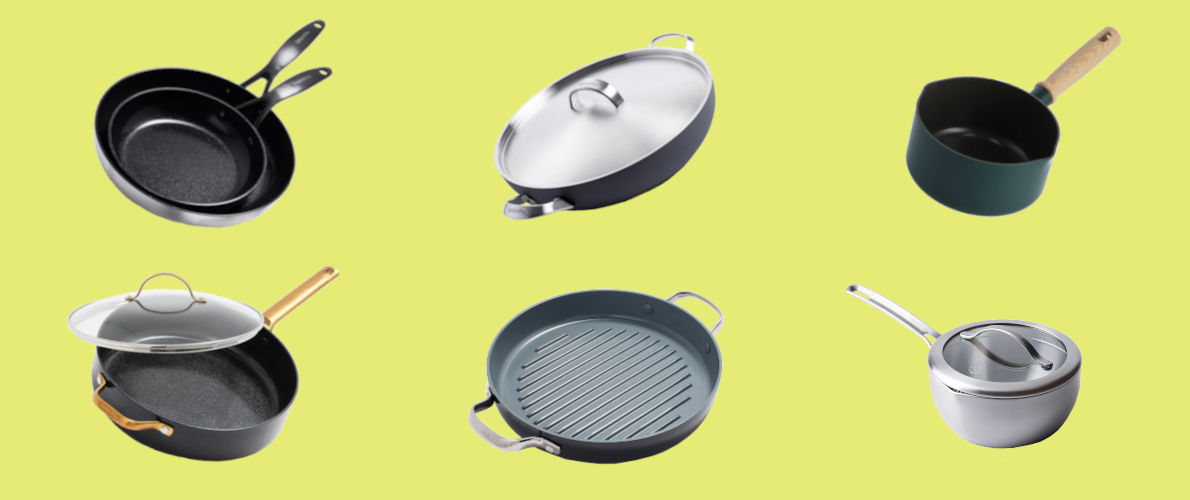
WHEN IT COMES to non-toxic cookware, GreenPan has long been ones that take the most places on our ceramic cookware favorites. In fact, GreenPan is an industry leader in who has the widest line of collections on the market. An indisputable key behind this success is its ThermolonTM —the company’s initiative non-Teflon coating—that cooks effectually than most ceramic coatings and makes many rivals to leave behind their footsteps. That’s why GreenPan claimed their products are “healthy” and “non-toxins”.
Yet, there’re lots of questions following the claims. Is it 0% toxins? Is it safer than Teflon pans? Does it work really that great? Is it worth to buy? Or which one is to get? To clear all doubts, we break down the jargon and explain things on a simpler way. Below is a section on each GreenPan’s collection you'll want to know about when you browse for buying.
TABLE OF CONTENTS:
Officially started in 2007 by two school friends: Jan Helskens and Wim De Veirman, GreenPan is a pioneer that shirked on the use of toxic chemicals in non-stick cookware that raised fearsome health matters from “forever pollutants” at that time. After a long search, they found a game changer: Thermolon, an effective ceramic coating.
Now, GreenPan is a dominant brand in the USA market and some countries, and a part of The Cookware Company who embraces the sustainable means to minimize impact on health and environment. Say, it’s a Belgium brand that outsources all production from China, except Thermolon from South Korea. GreenPan also has some popular sister brands: Blue Diamond, GreenLife, GreenChef, BK and Anotech Manufacturing.
Since GreenPan products advertised their products to be completely toxin-free, the company also mention to Thermolon as “healthy ceramic non-stick” containing “No PFOA, PFAS, lead or cadmium”. Is it true?
Back then, GreenPan used to claim that:
“Thermolon coating is made by a Sol-Gel process that results in forming a coating layer on the surface of the pan. This layer comprises mainly Silicon Dioxide (SiO2), which is the same composition as glass (or sand). There are some additional materials such as pigments that give the color.
All the materials in Thermolon are 100% safe for use in food contact coatings.”
This led to a class-action lawsuit entitled shopper Saldivar vs. The Cookware Company (USA) for false advertising in September 2019. The main concern is the way that they market on their website. The lawsuit alleges that:
As of December 2020, that lawsuit has been settled, and as the result, the claims have been dismissed “without prejudice” that means they can be brought again but no decision on the merits was reached.
At the time of reviewing (October 2022), GreenPan changed the claim on Thermolon. It still said that “derived from Silicon Dioxide, SiO2, which originally came from sand” and “the healthy choice”, but “100% safe” slogan has no longer existed—looks like the lawsuit did some effects.
Based on what we know until now, GreenPan isn’t entirely safe from possible toxins, but we don’t think it’s a greenwashing. Here’re the reasons to behind our thoughts:
PFOA-free doesn’t mean PFAS-free. In fact, a nonstick pan that advertises “PFOA-free” but doesn’t also say “PTFE-free” or “PFAS-free” likely contains PFAS. GreenPan isn’t 100% non-contaminants but—in at least—it safe from of Teflon (PTFE) and PFAS.
In essence, we rather agree with the claim: “a healthier choice”. GreenPan mightn’t be safe in absolute terms due to uncleanness of potentially toxic substances, but it’s more carefree to cook than Teflon. That’s why we keep the brand in our favorite lists.
GreenPan said: “Thermolon doesn’t come off during normal use. However, if abused (e.g., impact or wrong use of utensils), any coating can become scratched or even come off in small areas.” So, it’s important to follow the company’s instructions to make it safer and longer lifetime. Here’s how to get the most out of the pans.
This is such a baffling matter. Why? We dare to say: GreenPan has the broadest collections in “non-toxic cookware” market. Of course, all the products come with Thermolon coatings, but they vary by material build, style and cooktop capability. Some also designed for specific duties, like the SearSmart or Levels. You can see all collections available below.
(Oct 2022 updated)
| Structure | Oven-safe (max) | Induction-safe | Dishwasher-safe | Metal utensil-safe | Key features | |
|---|---|---|---|---|---|---|
| GP5 | 5mm hard anodized aluminum + Infinite8 ceramic coating | 600°F | Yes | Yes | Yes |
|
| Omega | Hard-anodized aluminum | 600°F | Yes | Yes | Yes |
|
| Mayflower Pro | Hard-anodized aluminum | - | Yes | No | No |
|
| Paris Pro | Hard-anodized aluminum | 600°F | Yes | Yes | No |
|
| Performance Pro | Hard-anodized aluminum | 600°F | Yes | Yes | No | |
| Valencia Pro | Hard-anodized aluminum | 600°F | Yes | Yes | No | |
| Venice Pro (& Noir) | 3-ply stainless-steel | 600°F | Yes | Yes | No |
|
| Five Two at Food52 | 3-ply stainless-steel | 600°F | Yes | Yes | No |
|
| Structure | Oven-safe (max) | Induction-safe | Dishwasher-safe | Metal utensil-safe | Key features | |
|---|---|---|---|---|---|---|
| Canterbury | Hard-anodized aluminum | 600°F | No | Yes | Yes | |
| Chatham | Hard-anodized aluminum | 600°F | No | Yes | Yes | |
| Reserve & Padova | Hard-anodized aluminum | 600°F | No | Yes | No | |
| Chatham Stainless | 3-ply stainless-steel | 600°F | Yes | Yes | Yes | |
| TriClad | 3-ply stainless-steel | 600°F | Yes | Yes | Yes |
|
| Structure | Oven-safe (max) | Induction-safe | Dishwasher-safe | Metal utensil-safe | Key features | |
|---|---|---|---|---|---|---|
| Hudson | Forged Aluminum | 350°F | No | Yes | No | |
| Rio | Forged Aluminum | 350°F | No | Yes | No | |
| Simmerlite | Forged Aluminum | 350°F | Yes | Yes | No |
|
| Swift | Forged Aluminum | 600°F | No | Yes | No |
|
| Treviso | Encapsulated base | 600°F | Yes | Yes | No | |
| Lima | Hard-anodized Aluminum | 600°F | No | No | No | |
| GreenLife Soft Grip | Aluminum | 350°F | No | Yes | No | |
| GreenLife Artisan | Aluminum | 600°F | No | Yes | No |
| Structure | Oven-safe (max) | Induction-safe | Dishwasher-safe | Metal utensil-safe | Key features | |
|---|---|---|---|---|---|---|
| Levels | Hard-anodized aluminum | 400°F | No | Yes | No |
|
| Levels Stainless | 3-ply stainless-steel | 400°F | Yes | Yes | No |
|
| SearSmart | Extra Hard-anodized aluminum | 600°F | No | Yes | No |
|
| SmartShape | Hard-anodized aluminum | 320°F | Yes | Yes | Yes |
|
GreenPan seems to never tire of releasing new products each year, so there’re tons of products here. As a guide, these’re some of our favorites:
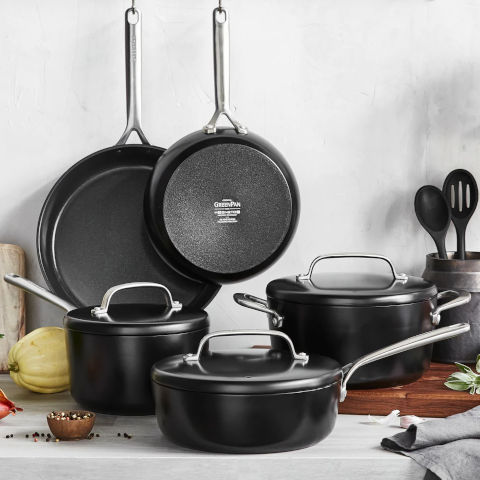
This is the highest peak of GreenPan, which somewhat reminds us of Caraway—quality made, good heat ability, effective nonstick and a minimal beaty. With a very thick 5-mm hard-anodized and Infinite8 ceramic (a new finest Thermolon coating), we’re not surprised if it heats evenly, retains heat well, or has a solid weight.
It has some nifty features for advanced cooking—stainless-steel lids, smooth rivets and “Balance Pro Base”, a new innovative surface found in GP5 and Omega. This lets oil to stay anyplace you put that makes better sautéing and searing effects with less oil. If you wish for a substantial ceramic cookware for serious routines and can spend more, it’s worth to go.
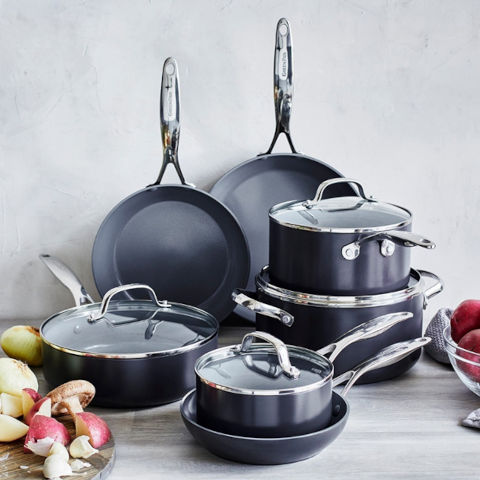
This is the best-selling products, highly recommended by many experts and home cooks, counting America’s Test Kitchen. It’s made quality, heats quick and evenly, gives an effective nonstick power, has a pleasing scratch-resistant surface and is easy to use.
Flexible cooking, the Valencia works on every stovetop, including induction burners, and is dishwasher- and oven-safe up to 600°F—a perfect daily workhorse for any cooking levels, from beginners to pros.
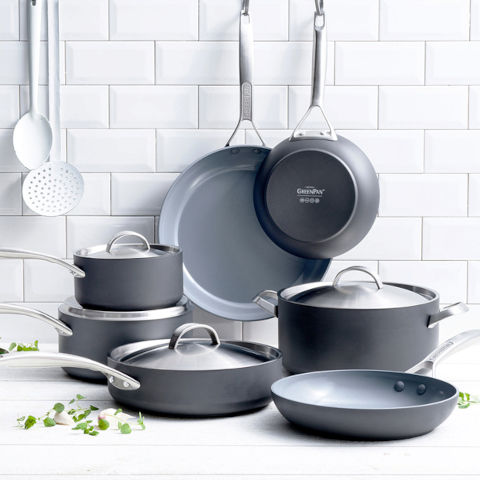
Except an induction compatibility, the Paris has nearly the same characteristics as the Valencia Pro—either construction, performance or durability. So, if you don’t work on induction stoves, it’s a more reasonable workhorse for serious cooks that can save your budget at least $50.
Another gain, you’ll get stainless-steel lids (instead of glass lids) that can resist a higher temperature cooking and put in oven if needed. However, some might prefer glass lids, vice versa.
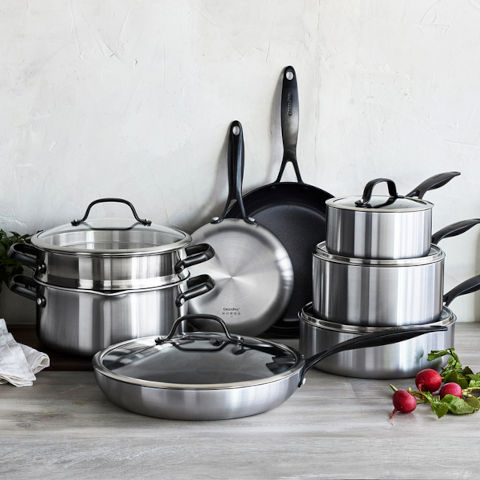
The Venice also gives impressive outcomes as a Pro series. Its 3-ply clad construction make heating up a bit slower than the all-aluminum bodies, like Valencia or Paris, but also disperses temperature evenly all over the pan and gradually heating for steady browning. However, it feels much sturdier and is compatible with any stovetops. We do like the pouring spouts and built-in strainer lids for pouring and draining water from ingredients at ease, and the stylish modern look is also the precious.
The overall specs can be pared with Five Two at Food52, just a little difference in design.
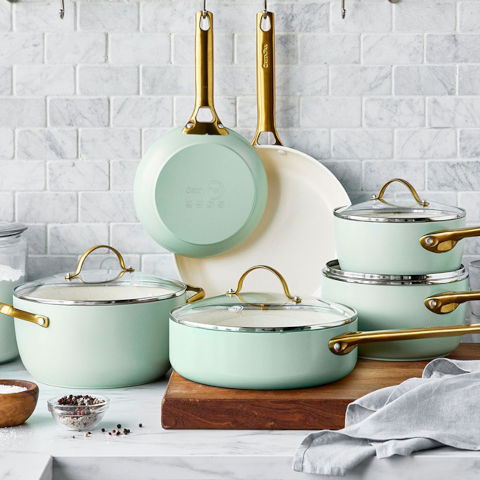
This is one of most gorgeous staples that is perfect for matching to any of your color décor or being a dapper gift to someone. Not only eye-catching, but it’s also a vivid performer as giving pleasing heat performance and nonstick ability. It cooks well for delicate tasks, such as cheesy, fish, seafood or egg-base dishes. It has the same hiccup as the Padova: easy to chip. So, you need to handwash, though it’s labled “dishwasher-safe”.
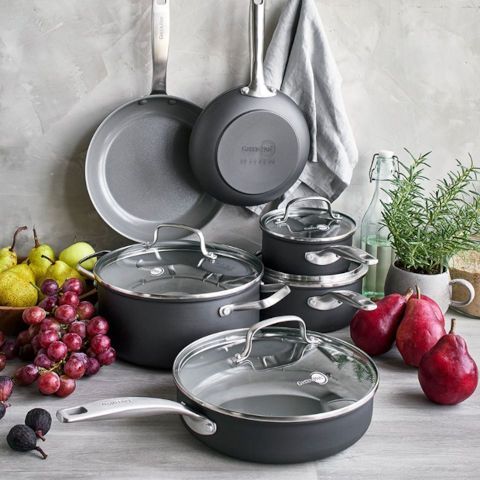
The Chatham stands at a sweet spot of quality, performance, practicality and price. The overall performance is in somewhere between the Pro (like Valencia) and the beginner levels (like the Lima or Rio), and it uses the good-graded Thermolon that makes a decent scratch-resistance.
It also claims for dishwasher- and metal utensil-safe, but we recommend handwashing and using soft utensils for a longer lifespan. For frequent home cooks, it should fulfill your regular routines adequately.
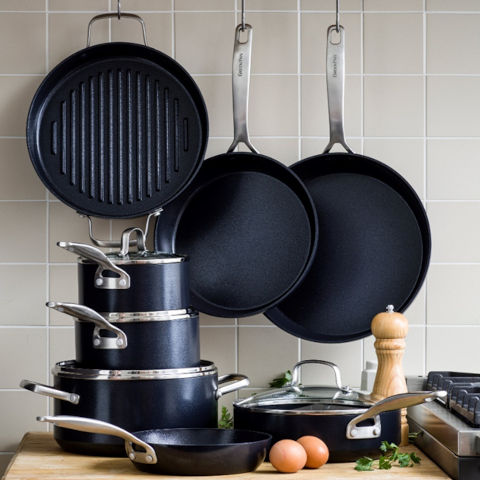
If you often sauté, sear, brown or make steaks but still want to go on nonstick cooking, this is an unbeatable choice. The SearSmart, like the name, is designed for these techniques. It has a slightly rough-textured surface, a 40% more cooking space than other collections and solid body and coating that can survive high heat.
It’s not a true sear master like those stainless-steel and cast-iron pans but does give good searing/browning results far better than most nonstick contenders and is lighter than those steel pans.

The Levels is an advocating solution for cooking in a tiny kitchen or keeping things more tidily. When stacked, it can be piled up compactly to an only 13.5” tall stack, without scratching to each other, and requires 30% less storage to keep. Unlike most space-saving or nestable sets, it’s friendlier to use as providing a close to standard-sized cookware set—standard capacity, regular glass lids and fixed handles.
We also like the trainer lids and pour spouts, which helps draining water, without a need of extra colanders.
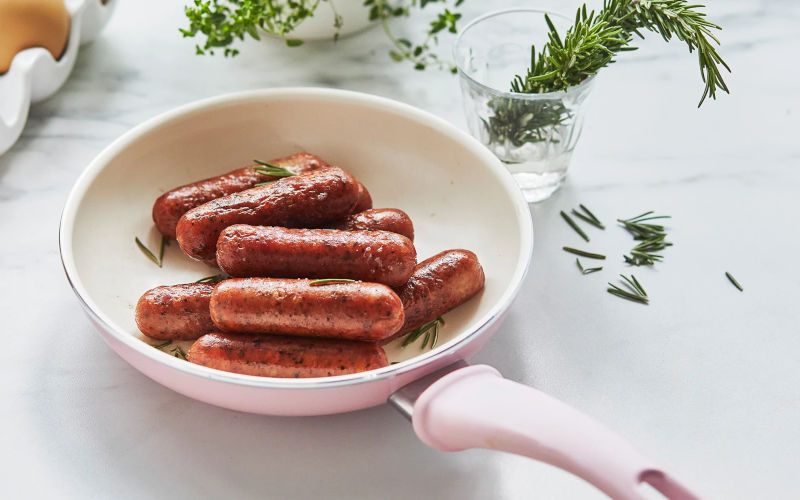
When talking about GreenPan, it's impossible not to think of GreenLife, GreenChef and Blue Diamond—the sister brands. Clearly, GreenPan is positioned in a upper level that is full of technologies, neater crafts and impressive features, while the inferior brands were later added to fill a gap in the economical range.
What they all have in common is: Thermolon coating. But either cooking performance, nonstick coating or durability, they’re inferior. Like other inexpensive players, they’re likely to lose nonstick ability, appear chips and dent, and since most products are made of aluminum or thinner stainless-steel, they’re noticeably less sturdy.
For budget-restricted people who want to give a try on health-conscious cookware, they’re decent choices. At least, you’ll got a greener nonstick cookware—no PTFE, PFAS, lead and cadmium—that has a nice nonstick ability without breaking the bank.
In fact, GreenLife and Blue Diamond are both best-sellers. Until now, GreenLife received excitingly positive feedbacks on Amazon.com from over 40,000 reviewers and nearly 30,000 reviewers for Blue Diamond. (GreenChef seems not as popular as these two, though.) Honestly, we rather like GreenLife Soft Grip than GreenPan Rio due to the resemblance of specification and appearance, at a half price cut down.
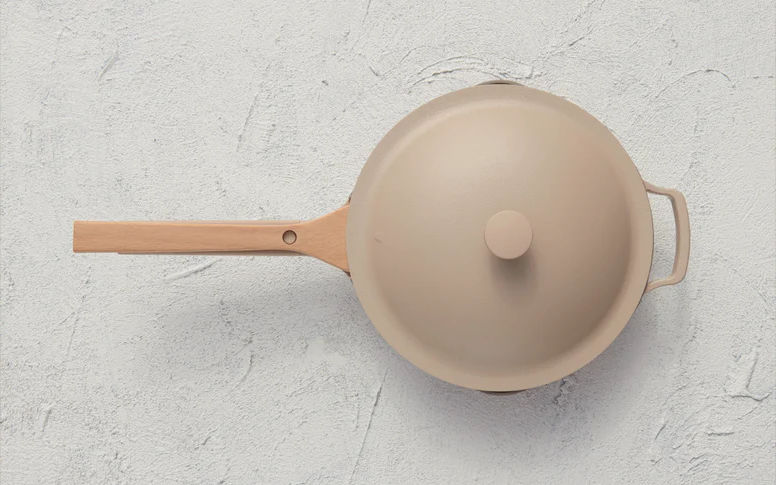
There’re many social-raving direct-to-consumer brands in the ceramic market lately. Are these new faces better or safer?
Caraway: This seems to be a closest competitor due to the absence of PTFE, PFOA, other PFAS, lead, cadmium, or toxic metals, with up to 550°F heat proof (comparing to 600°F of GreenPan), but GreenPan clearly accents a better value and has wider variety of products. In terms of key features and appearance, we think the GP5 is very comparable to Caraway but offers somewhat better heat performance and a harder body. Good news, you don’t need that topnotch because the GreenPan Pro Series—like Valencia, Venice, or Paris—suffice to get jobs done beautifully, in less dollars to pay.
Equal Parts: It’s claimed for “PTFE- and PTOA-free”—not entirely PFAS-free. Also, it has a low heat resistance, up to 450°F like common nonstick pans.
Our Place (Always Pan): It has a nonstick ceramic coating that free from PFOA, PTFE, other PFAS, lead, cadmium, toxic metals and nanoparticles—quite like the Thermolon coating. But at $145* for a 10” pan set, unless you frequently cook one pot dishes or need a multi-tasker for a small cooking place, it’s rather pricy and can be used on stovetop only.
Scanpan: We’ve no doubts about its craft quality, performance and durability of nonstick coating—all are remarkable. Both STRATANIUM and STRATANIUM+ coatings are real durable and long-lasting. However, while Scanpan pans are PFOA- and PFOS-free, they do contain some PTFE—not literally PFAS-free. Bad news for those who want to skip Teflon pans.
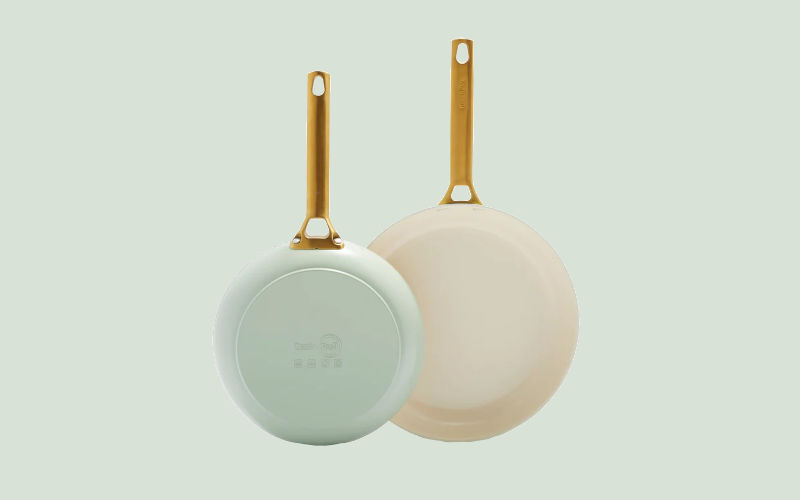
Finally, if you decided to get their products, so which one is to get? These’re some of our easy but legit references for the common practices: if you…
So, is GreenPan a worthy alternative to those Teflon (PTFE) pans? Definitely. Why? You’ll get a lightweight-and-effective nonstick cookware that is free from entire PFAS (not just PFOA or PFOS) and can endure overheat than conventional ones, with no worry about any toxic fumes released—though it’s recommended to keep around low to medium-high heat.
Design-friendly, it also has comfortable handles and lids, a nice assortment, built-in strainer lids (in some models) and an undeniably chic look. You still need to handwash and skip metal, sharp-edged utensils for preserving the nonstick coating. With proper use and care, it should last for 2-5 years—the superior collections tend to last longer.
We also appreciate GreenPan’s intent to “go greener” like using recycled materials as much as possible, emitting less CO2 and dealing with their wastewater. These’re praiseful practices that all companies should keep for better sustainability.